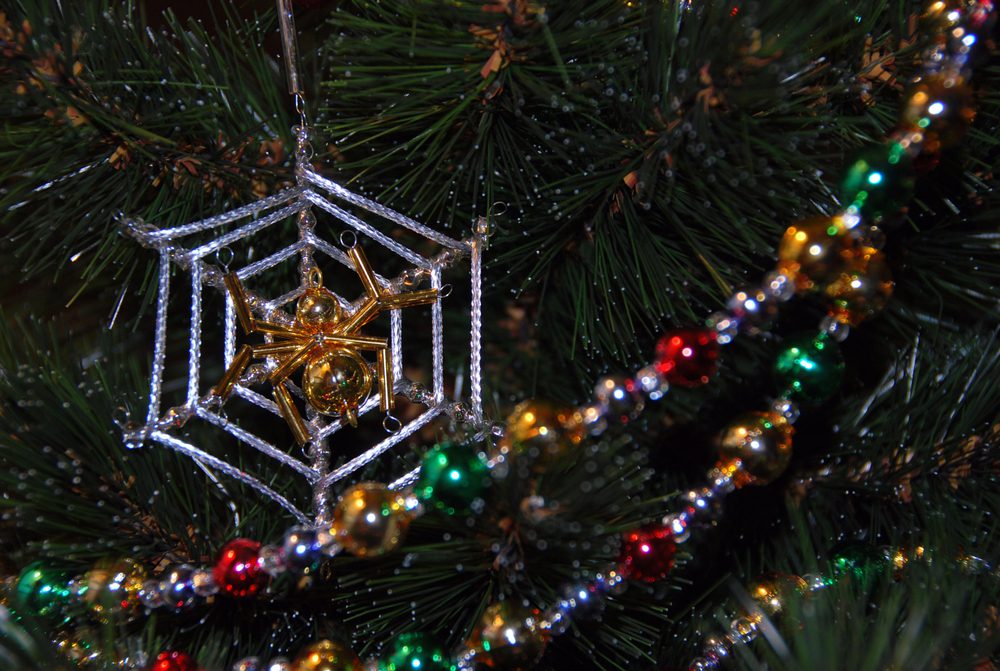What comes to mind when you hear the word “Christmas”? Turkey, twinkling lights, a jolly man in a red suit… and hairy, eight-legged arthropods? While many people run in terror from spidery visitors in their homes, what they may not know is how these critters gave rise to a festive tradition that has endured to this day.
The Legend of the Christmas Spider is a European folktale that is particularly prevalent in Western Ukraine, where spiders and their webs are considered omens of good luck around Christmas time. The most prevalent version of the story goes something like this:
A poor widow and her children are excited to find that a pinecone has dropped from a nearby tree and taken root outside their hut. The children tend the tree as it grows, thrilled that they will have a proper tree for Christmas. However, when Christmas Eve comes around, the tree remains bare, as the family is unable to afford to decorate it. Hearing how upset the children are, the resident spiders take pity on them and get to work, spinning their webs around the tree branches.
The children are overjoyed when they wake up to see their beautifully decorated tree. As the Sun rises on Christmas morning, its rays touch the glittering strands of spiderweb, turning them to silver and gold; and so, the family’s fortunes were turned around, and they never wanted for anything again.
There are other variations of the legend. A couple of these, from Ukraine and Germany, involve a Christmas tree being decorated in preparation for, variously, a visit from Santa Claus or from baby Jesus himself. The household spiders, being excited to look at the tree but too small to see it from the floor, go crawling all over it to get a closer look, leaving webs in their wake.
Depending on which version of the story you’re reading, when Santa/Jesus arrives at the house they are loath to destroy the spiders’ handiwork – the little guys were just excited, after all – but recognize that the family might be a bit miffed to find their perfectly decorated tree covered in webs. The solution is to magically transform the webs into shimmering silver and gold strands.
Eight hairy legs, seven swans a-swimming, six… – what do you mean that’s not how it goes? Image credit: Alyona Raikher/Shutterstock.com
Spiderweb-shaped ornaments remain a common sight on Christmas trees in Ukraine to this day. And, though you might not have realized it, another decorative flourish inspired by this story can be found in Christmas displays all over the world: tinsel.
It may not be everyone’s decoration of choice, but there is no denying the continuing popularity of tinsel. Whether you use it to line doorframes and windows, wear it in place of a necktie for your office holiday party, or festoon your long-suffering pet, its primary use for many generations has been on the Christmas tree. Tinsel garlands, or the narrow strands known as lametta, mimic the silvery spiderwebs of legend.
Use of the word “tinsel” is thought to date back to the 16th century, where it likely arose from the old Anglo-French verb tenceler – to sparkle. Once made of real silver, there was a regrettable foray into using lead before safer (although not so environmentally conscious) plastic-based materials were settled upon. And, while it’s difficult to definitively prove that the use of tinsel on Christmas trees is solely down to a festive tale about a spider, we have to admit that we’re quite attached to the idea.
So, the next time you have an eight-legged visitor around the holidays, consider remembering that it could be a sign of good fortune to come. Although, even we admit that finding 81 of them chilling on your tree might be a step too far.
Source Link: Have You Heard The Legend Of The Christmas Spider?
